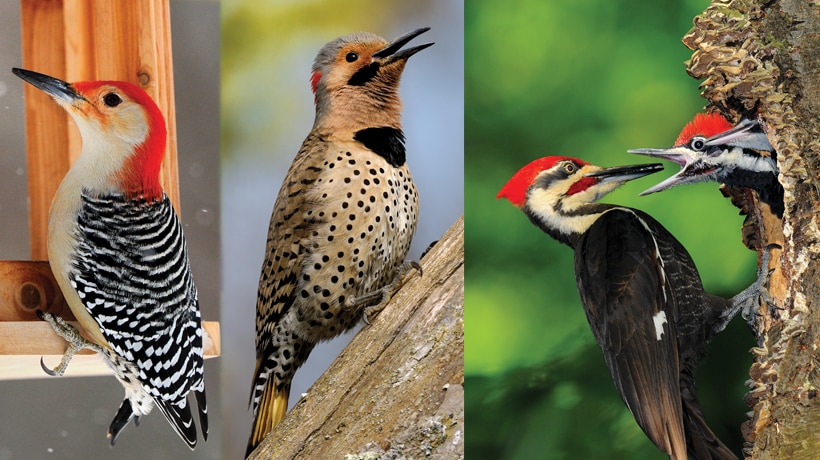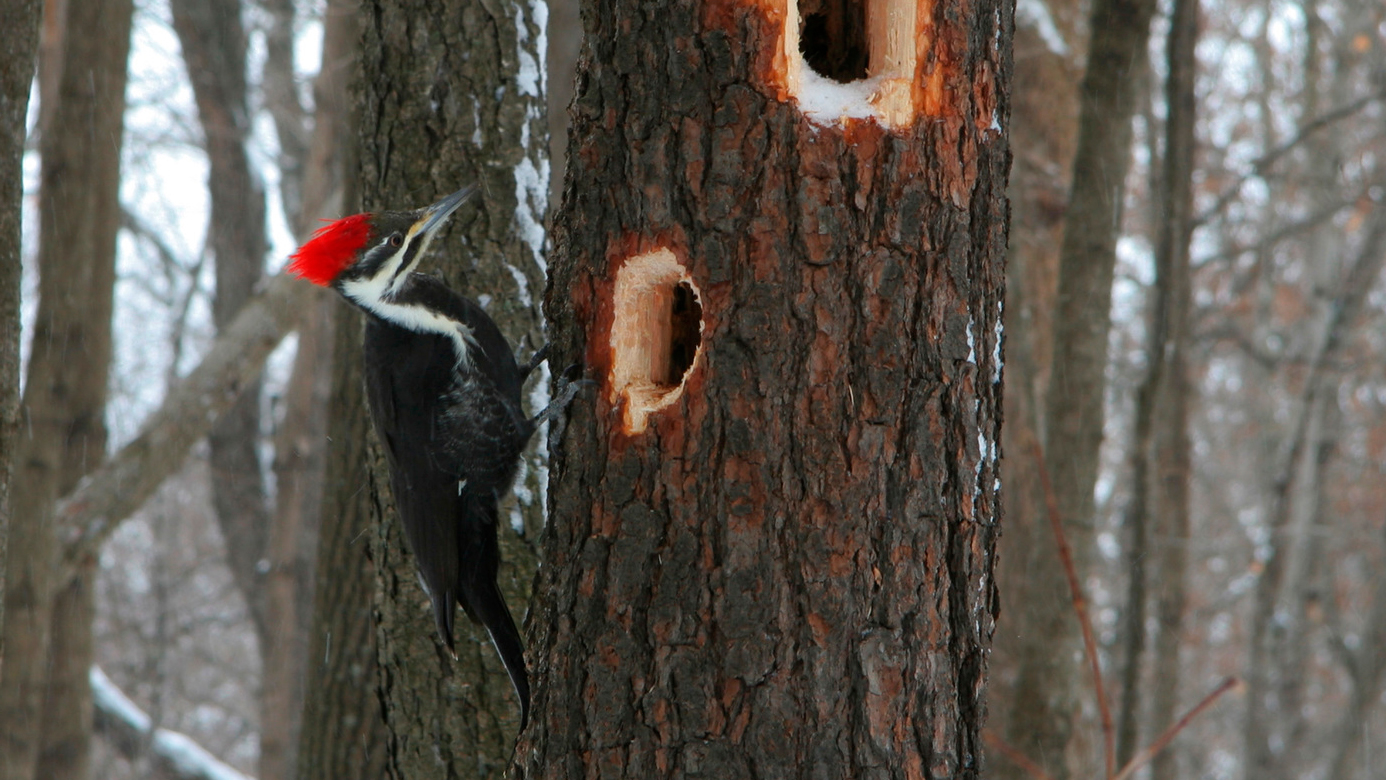Checking Out Woodpeckers in Florida Habitats: Where to Identify These Birds
Wiki Article
Woodpeckers: A Comprehensive Overview to Recognizing These Unique Birds
Woodpeckers, with their distinct actions and physical features, have long mesmerized the interest of ornithologists and nature lovers alike. As we explore the elaborate makeup, diverse species, and ecological importance of woodpeckers, a deeper appreciation for these one-of-a-kind birds and the mysteries they hold unfolds.
Woodpeckers' Drumming Habits
Woodpeckers display a balanced and exact drumming actions that serves numerous crucial features in their every day lives. This behavior is largely associated with communication, area defense, and foraging. The distinctive drumming sound is created by the rapid pecking of their beaks versus hard surfaces such as tree trunks, branches, and even steel things.Interaction is an important element of woodpecker actions, and drumming plays a significant function in this process. Woodpeckers use drumming to establish their presence, draw in friends, and preserve contact with their partners and offspring. The regularity, intensity, and duration of drumming sequences share particular messages to other woodpeckers in the area.
Along with communication, woodpeckers use drumming behavior for region defense. Woodpeckers in Florida. The loud and recurring drumming functions as a cautioning to possible trespassers, signaling that the area is currently declared. By establishing their area via drumming, woodpeckers lower the chance of problems over important resources such as food and nesting websites
Additionally, woodpeckers additionally utilize drumming as a foraging method. The rhythmic pecking helps them situate bugs concealing underneath the bark of trees by creating vibrations that interfere with the target's cover-up. This behavior showcases the flexibility and resourcefulness of woodpeckers in utilizing their drumming abilities for several vital objectives.
Unique Adaptations for Tree Climbing
Having actually mastered the art of drumming to connect, protect region, and forage, woodpeckers have actually progressed distinct adaptations that promote their amazing climbing capabilities in their arboreal habitats. One essential adaptation is their specific feet. Woodpeckers have zygodactyl feet, with two toes aiming forward and two toes pointing backwards. This setup offers a strong grasp on the upright surface areas of trees, enabling them to cling easily while foraging for insects or drumming. In addition, woodpeckers have tight tail plumes that serve as a prop to sustain their bodies as they climb. These tail feathers supply stability and equilibrium, making it possible for woodpeckers to maneuver up tree trunks with precision and agility.Additionally, woodpeckers have effective neck muscles and an one-of-a-kind skull framework that aid in their climbing capacities. Their solid neck muscles permit Go Here them to swiftly peck at tree bark without experiencing whiplash, while their thick skull and little mind function as shock absorbers, securing them from the influence of duplicated drumming. These adaptations collectively allow woodpeckers to navigate the vertical world of trees with effectiveness and poise.

Role of Woodpeckers in Ecological Communities
By foraging for pests under the bark of trees, woodpeckers assist control bug populaces, protecting against episodes that might hurt the overall health and wellness of the forest. Additionally, woodpeckers produce dental caries in trees that serve as essential nesting websites for a range of various other bird varieties, promoting biodiversity within the environment.Moreover, the drumming and vocalizations of woodpeckers play an important duty in interaction and territory establishment. These noises not just offer to bring in friends yet likewise assist specify limits in between different woodpecker areas, decreasing problems and advertising a harmonious coexistence within the woodland area. Generally, the presence of woodpeckers in woodland ecological communities highlights their value as keystone types, affecting the characteristics and functioning of these environments in complex means.
Makeup: Specialized Beaks and Feet
In the elaborate internet of forest ecosystems, the specialized beaks and feet of woodpeckers are crucial adjustments that allow them to fulfill their essential ecological roles. Woodpeckers have distinct anatomical features that are particularly developed to aid them in their foraging and nesting behaviors.The most distinguishing characteristic of woodpeckers is their solid, chisel-shaped beaks. These beaks are flawlessly adapted for drilling right into wood to reveal insects, larvae, and sap hidden beneath the bark of trees. The solid muscle other mass and pop over to these guys durable structure of their beaks allow woodpeckers to peck at a price of as much as 20 times per secondly without creating damages to their skulls.
In addition, woodpeckers have actually specialized feet that help in their acrobatic climbing capabilities. Their feet have 2 toes pointing onward and 2 toes aiming in reverse, supplying a solid grasp on upright surface areas (Woodpeckers in Florida). This distinct foot setup, along with tight tail plumes that work as an encouraging prop, enables woodpeckers to hold on to tree trunks and branches effortlessly while they look for food or dig deep into nesting cavities
Woodpecker Types Diversity
Woodpeckers are a varied team of birds found across various environments worldwide, with over 200 recognized species displaying adaptations to different settings. Woodpeckers have developed to inhabit a range of atmospheres, from woodlands and forests to meadows and deserts, each providing special obstacles that have influenced the development of distinct woodpecker species.Another adding element to woodpecker types diversity is their specialized feeding actions. Various types have progressed to manipulate different food sources, such as insects, tree sap, fruits, and nuts, causing the growth of certain adjustments in beak form, dimension, and toughness. These adaptations make it possible for woodpeckers to forage effectively in their respective habitats, decreasing competitors amongst species and promoting specific niche distinction. In addition, geographical isolation and historic variables have actually played a function in shaping the circulation and variety of woodpecker species, resulting in the vast array of specialized adjustments seen in these remarkable birds.

Verdict
In verdict, woodpeckers are remarkable birds that display one-of-a-kind drumming habits, specialized adjustments for tree climbing, and play crucial duties in ecological communities. Their composition, including specialized beaks and feet, enables them to prosper in their setting. With a varied series of woodpecker varieties discovered worldwide, these birds are important for keeping the health and wellness and balance of forests and forests. Recognizing and appreciating the details of woodpeckers can offer important understandings into the environment.Report this wiki page